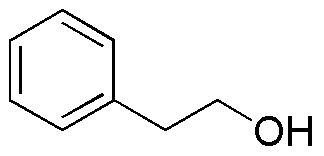2-Phenylethanol is widely utilized in research focused on:
- Fragrance and Flavor Industry: This compound is a key ingredient in perfumes and cosmetics, providing a pleasant floral scent. Its natural aroma makes it a preferred choice over synthetic alternatives.
- Pharmaceuticals: It serves as a solvent and intermediate in the synthesis of various medicinal compounds, enhancing drug formulations with its stabilizing properties.
- Food Industry: Used as a flavoring agent, it adds a sweet, rose-like flavor to food products, making it popular in confectionery and beverages.
- Biotechnology: In research, it acts as a precursor for synthesizing other compounds, facilitating studies in organic chemistry and material science.
- Antimicrobial Applications: 2-Phenylethanol exhibits antimicrobial properties, making it useful in developing preservatives for personal care products and food items.
General Information
Properties
Safety and Regulations
Applications
2-Phenylethanol is widely utilized in research focused on:
- Fragrance and Flavor Industry: This compound is a key ingredient in perfumes and cosmetics, providing a pleasant floral scent. Its natural aroma makes it a preferred choice over synthetic alternatives.
- Pharmaceuticals: It serves as a solvent and intermediate in the synthesis of various medicinal compounds, enhancing drug formulations with its stabilizing properties.
- Food Industry: Used as a flavoring agent, it adds a sweet, rose-like flavor to food products, making it popular in confectionery and beverages.
- Biotechnology: In research, it acts as a precursor for synthesizing other compounds, facilitating studies in organic chemistry and material science.
- Antimicrobial Applications: 2-Phenylethanol exhibits antimicrobial properties, making it useful in developing preservatives for personal care products and food items.
Documents
Safety Data Sheets (SDS)
The SDS provides comprehensive safety information on handling, storage, and disposal of the product.
Product Specification (PS)
The PS provides a comprehensive breakdown of the product’s properties, including chemical composition, physical state, purity, and storage requirements. It also details acceptable quality ranges and the product's intended applications.
Certificates of Analysis (COA)
Search for Certificates of Analysis (COA) by entering the products Lot Number. Lot and Batch Numbers can be found on a product’s label following the words ‘Lot’ or ‘Batch’.
*Catalog Number
*Lot Number
Certificates Of Origin (COO)
This COO confirms the country where the product was manufactured, and also details the materials and components used in it and whether it is derived from natural, synthetic, or other specific sources. This certificate may be required for customs, trade, and regulatory compliance.
*Catalog Number
*Lot Number
Safety Data Sheets (SDS)
The SDS provides comprehensive safety information on handling, storage, and disposal of the product.
DownloadProduct Specification (PS)
The PS provides a comprehensive breakdown of the product’s properties, including chemical composition, physical state, purity, and storage requirements. It also details acceptable quality ranges and the product's intended applications.
DownloadCertificates of Analysis (COA)
Search for Certificates of Analysis (COA) by entering the products Lot Number. Lot and Batch Numbers can be found on a product’s label following the words ‘Lot’ or ‘Batch’.
*Catalog Number
*Lot Number
Certificates Of Origin (COO)
This COO confirms the country where the product was manufactured, and also details the materials and components used in it and whether it is derived from natural, synthetic, or other specific sources. This certificate may be required for customs, trade, and regulatory compliance.


